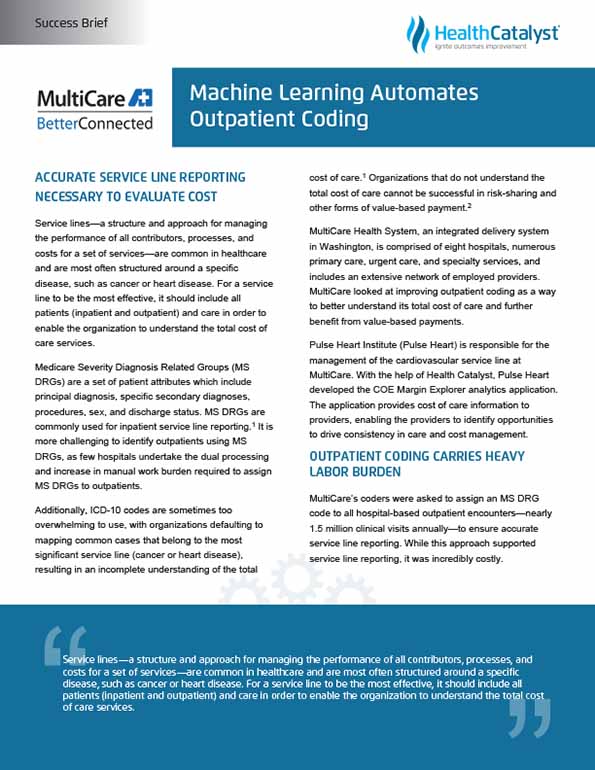Accurate service line reporting is necessary for healthcare organizations to understand the total cost of care. Read how MultiCare employed machine learning for its outpatient coding efforts and restored its service line reporting.
Service lines—a structure and approach for managing the performance of all contributors, processes, and costs for a set of services—are common in healthcare and are most often structured around a specific disease, such as cancer or heart disease. For a service line to be the most effective, it should include all patients (inpatient and outpatient) and care in order to enable the organization to understand the total cost of care services.
Medicare Severity Diagnosis Related Groups (MS DRGs) are a set of patient attributes which include principal diagnosis, specific secondary diagnoses, procedures, sex, and discharge status. MS DRGs are commonly used for inpatient service line reporting.1 It is more challenging to identify outpatients using MS DRGs, as few hospitals undertake the dual processing and increase in manual work burden required to assign MS DRGs to outpatients.
Additionally, ICD-10 codes are sometimes too overwhelming to use, with organizations defaulting to mapping common cases that belong to the most significant service line (cancer or heart disease), resulting in an incomplete understanding of the total cost of care.1 Organizations that do not understand the total cost of care cannot be successful in risk-sharing and other forms of value-based payment.2
MultiCare Health System, an integrated delivery system in Washington, is comprised of eight hospitals, numerous primary care, urgent care, and specialty services, and includes an extensive network of employed providers. MultiCare looked at improving outpatient coding as a way to better understand its total cost of care and further benefit from value-based payments.
Pulse Heart Institute (Pulse Heart) is responsible for the management of the cardiovascular service line at MultiCare. With the help of Health Catalyst, Pulse Heart developed the COE Margin Explorer analytics application. The application provides cost of care information to providers, enabling the providers to identify opportunities to drive consistency in care and cost management.
MultiCare’s coders were asked to assign an MS DRG code to all hospital-based outpatient encounters—nearly 1.5 million clinical visits annually—to ensure accurate service line reporting. While this approach supported service line reporting, it was incredibly costly.
As part of a broader strategic initiative to reduce systemwide cost, the coding department decided to outsource all encounter coding, which eliminated the coding of outpatient encounters, negatively impacting service line reporting. To understand the total cost of care, MultiCare needed a solution that would support service line reporting allowing the organization to fully recognize the millions of dollars in labor costs that went back into the organizational budget.
MultiCare turned to Health Catalyst for assistance in developing a solution for accurate service line reporting. By utilizing the Health Catalyst® Analytics Platform and catalyst.ai™, MultiCare was able to design a machine learning algorithm to predict the service line and MS DRG code for hospital-based outpatient encounters.
To develop the model, data analysts used 3,401,457 training cases from MultiCare’s historical data in the analytics platform. Subject matter experts from Health Catalyst and MultiCare worked in partnership to select input variables for the model. Twenty-five different input variables were considered, with five eventually being selected as the final input variables.
The model assigns each hospital-based outpatient encounter to one of 48 service lines, with 98 percent accuracy, and to one of 750 MS DRG codes, with 94 percent accuracy. The output of the model is visualized in the COE Margin Explorer analytics application.
By employing machine learning, MultiCare has successfully restored service line reporting, enabling the organization to better understand the total cost of care, and supporting future participation in value-based care and risk-sharing agreements.
Leveraging the analytics platform and catalyst.ai has allowed MultiCare to avoid purchasing costly third-party solutions. Additionally, MultiCare is able to avoid the labor costs that would be required to perform dual coding, saving more than $1M annually.
With a better understanding of its total cost of care, MultiCare plans to look for opportunities to further improve the care provided to its patients while decreasing the total cost of care.


